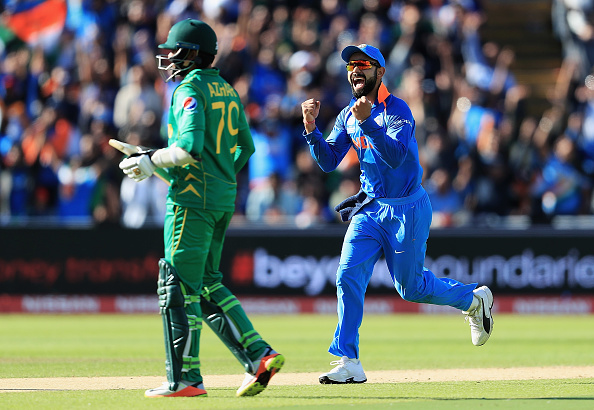Tim Wigmore says an Indian stronghold over Pakistan in limited-overs cricket makes the rivalry far less intense…
When India play Pakistan, the fixture is routinely described as the biggest rivalry in all sports. The geopolitical significance of the match remains huge, even if there is a welcome sense that a little sting has been taken out of the game. To be at Edgbaston for their latest meeting was not to see any great antagonism between supporters of the two teams. Altogether more common was the sight of Indian and Pakistani fans taking selfies with each other.
In one sense this game has ceased to be a true rivalry at all. A sporting rivalry depends on many things – shared history, shared geography, and classic contests in the past – but it is diluted without one essential ingredient: competitive balance.
When India play Pakistan the fundamental sporting balance in the game has now been lost. The game at Edgbaston was the fifth time in five years that India have faced Pakistan in an ICC event. They have won every time; on no occasion has the match been remotely close.
Instead, India’s margins of victory – eight wickets, seven wickets, 76 runs, six wickets and a crushing 124 runs in Birmingham – embody a rivalry that has become deeply one-sided. Like when England meet Scotland in football this weekend, all the hype cannot obscure an underlying truth: these are two sports teams with vastly differing abilities.
It is not that Pakistan are particularly spooked by playing India, either, more that the match affirms an essential truth: Pakistan are a distinctly underwhelming side in both limited-overs formats. They are now ranked eighth in ODI cricket, while India are third. Perhaps never in the history of their cricketing rivalry has one team been so ascendent on the pitch.
In many ways, the on-field disparity reflects that off the field. India, the sport’s economic behemoth, is banned by their government from playing Pakistan.
But, financially, they do not need to: they have their high-octane rivalries and elongated series with Australia and England; indeed, any nation in the world will do anything they can to accommodate matches with India, such is their financial worth. And, of course, India also has the Indian Premier League, a tournament that ensures riches with the national team even taking the field.
How envious Pakistan must be. They signed an agreement to play six series with India from 2015-23, including four for which Pakistan would be the designated hosts, earning around $50 million in broadcasting rights each series. India being banned by the government from fulfilling these obligations – though the government curiously makes an exception for ICC events, in which the draw is fixed to ensure the lucrative game takes place – is therefore crippling to the Pakistan board’s finances. So, too, is Pakistan’s inability to host matches against major opposition at home since 2009.
Perhaps the lopsidedness of the India-Pakistan rivalry should be no surprise. More than ever before, sport today reflects the socioeconomic environment in which it is played. It is why 90 per cent of how a football team performs over time can be predicted by their wage bill.
By the same logic, we can expect India, with a population seven times larger than Pakistan and a thriving economy, to become ever-more dominant against Pakistan. For all the history of the rivalry, the hype is in ever-more danger of seeming force.
Where India and Pakistan are concerned, hype does not bring exciting cricket
This piece originally featured in The Cricket Paper, June 9 2017
Subscribe to the digital edition of The Cricket Paper here












